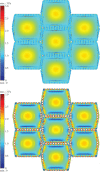Shear-induced force transmission in a multicomponent, multicell model of the endothelium
- PMID: 24966239
- PMCID: PMC4233691
- DOI: 10.1098/rsif.2014.0431
Shear-induced force transmission in a multicomponent, multicell model of the endothelium
Abstract
Haemodynamic forces applied at the apical surface of vascular endothelial cells (ECs) provide the mechanical signals at intracellular organelles and through the inter-connected cellular network. The objective of this study is to quantify the intracellular and intercellular stresses in a confluent vascular EC monolayer. A novel three-dimensional, multiscale and multicomponent model of focally adhered ECs is developed to account for the role of potential mechanosensors (glycocalyx layer, actin cortical layer, nucleus, cytoskeleton, focal adhesions (FAs) and adherens junctions (ADJs)) in mechanotransmission and EC deformation. The overriding issue addressed is the stress amplification in these regions, which may play a role in subcellular localization of mechanotransmission. The model predicts that the stresses are amplified 250-600-fold over apical values at ADJs and 175-200-fold at FAs for ECs exposed to a mean shear stress of 10 dyne cm(-2). Estimates of forces per molecule in the cell attachment points to the external cellular matrix and cell-cell adhesion points are of the order of 8 pN at FAs and as high as 3 pN at ADJs, suggesting that direct force-induced mechanotransmission by single molecules is possible in both. The maximum deformation of an EC in the monolayer is calculated as 400 nm in response to a mean shear stress of 1 Pa applied over the EC surface which is in accord with measurements. The model also predicts that the magnitude of the cell-cell junction inclination angle is independent of the cytoskeleton and glycocalyx. The inclination angle of the cell-cell junction is calculated to be 6.6° in an EC monolayer, which is somewhat below the measured value (9.9°) reported previously for ECs subjected to 1.6 Pa shear stress for 30 min. The present model is able, for the first time, to cross the boundaries between different length scales in order to provide a global view of potential locations of mechanotransmission.
Keywords: adherens junctions; endothelial cell mechanics; focal adhesions; glycocalyx; mechanotransmission; stress fibres.
© 2014 The Author(s) Published by the Royal Society. All rights reserved.
Figures









References
Publication types
MeSH terms
Substances
Grants and funding
LinkOut - more resources
Full Text Sources
Other Literature Sources
Research Materials
Miscellaneous

